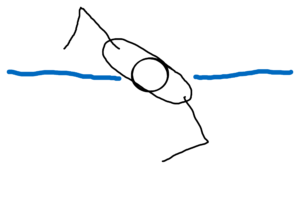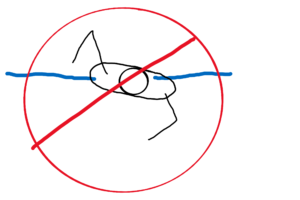In the times we live in, we are all looking for ways to continue to improve when we can only rely on limited resources to guide us. To that end, it was suggested that I could offer some advice on how our members could continue to improve their strokes and swimming technique. While feedback is a gift, advice is, well, another matter entirely. Whenever I’m asked for advice, I think to a couple I know well who’ve been married for over 50 years. They were asked by someone if they’d be available to offer advice on marriage. They, I think rightly, asked how they could possibly give advice to anyone as they only know how they have made their own marriage work, not someone else’s. In a similar way, I wonder if I have any credibility to offer advice on how someone else can manage their own stroke technique. But, into the breach I go…
What do I hope to offer?
I hope to share a few thoughts gained from my swimming experience that began over 40 years ago with age-group swimming. (Yes, my perspective on swimming may be a little different than some of you.) I have been blessed by quite a few coaches, each with their own perspectives on the value of coaching, swimming, and competing. When a swimmer was not as tall, strong or gifted as other swimmers, coaches focused on maximizing any abilities and skill that we could develop to compete. I have also spent a little time reading the thoughts of coaches and swimmers through books and videos to try to understand how other swimmers train and techniques that they might use to improve. I hope to share a few of my thoughts that might help you think a little differently about your own swimming, understand the guidance you might have received in the past and try to understand why parts of your own swimming may not ‘feel’ right or might actually cause you injury.
So, as this is the first of what might be several short pieces about swimming, let’s start with something simple, but first
Why you swim should drive how you practice
If you want to become proficient at some skill, you practice that skill repetitively, focusing on your own technique and avoiding injuries. When I was learning to swim, we didn’t call our sessions with coaches ‘training,’ they were ‘practice’ sessions. That distinction is important. The sessions are practice for your swimming. So, it’s important to be honest about why you are spending time swimming. You don’t need to share that information with anyone. The answer is just for you and can help focus why you spend time in the water. Your answer can change over time depending on your goals, your time, and your own needs.
For example, if you train to get in shape, you may not honestly want to improve your stroke more than just to avoid injury. An inefficient (but injury avoiding) stroke in swimming is a great way to expend energy and get stronger. Getting more efficient in the water will actually mean that it takes you longer to burn calories. As you become more efficient at swimming, you may need to use tools in order to help you use your time efficiently while practicing. You know those tools: kickboards, pull buoys, snorkels, drag shorts, etc. The tools provide focus on specific areas of swimming in a targeted way. They aren’t just torture devices! But, you have to be aware of how to use each of the tools.
Be honest with yourself about what you want to achieve.
How can I make my stroke better?
There is no perfect stroke, only the perfect stroke for you. I’m regularly corrected that the over-arm crawl is called the Front Crawl. But, I think that, from a swimming perspective, as long as you’re not competing in a swim competition where stroke rules guide allowed techniques, we should give ourselves the freedom to swim FreeStyle. Swim how you want to get what you want out of it.
But, if that’s true, why do so many people tell me to swim with ‘high elbows?’
Why do they tell me to swim with high elbows?
Have you been told to try to swim with ‘nice high elbows?’ Sure, you have. I would doubt anybody has told you why. That’s nobody’s fault, it just takes some time to explain. An explanation could go on for pages. To name a few reasons: potential to decrease shoulder injury, easier breathing, balanced stroke, even muscle development, ease of movement. Now, that sounds good, right?
I’m going to explain just one small part of how this approach to swimming can help you.
Done correctly, swimming with high elbows forces you to rotate your body.

But, let’s be clear of what ‘high elbows’ actually means. Did you know you can be swimming with high elbows while your arm is straight? The key point here is how the elbow is positioned with respect to the body and being aware of how you are using your body. When swimming, you want to be efficient at making forward progress. Any energy used in some way that doesn’t aid that progress is wasted.

Also, the position of your forearm is not really part of this discussion, although it can be included. You may need to change the position of your arm for many reasons, such as: waves, avoiding other swimmers, nearby rocks, or even the side of a pool. The focus here is your elbow.
Swimming with high elbows is primarily not the result of raising your arms back. It is a result of rotating your body and only raising your elbows slightly. And, that’s actually a key point to swimming: Slight actions result in big improvements.
How does swimming with high elbows help you?
- A shallow angle between the back and upper arm means less stress on joint.
- A higher raised elbow means less torque on your shoulder as gravity presses down on your arm.
(Think of this as a smaller fulcrum against which gravity can work.) - Less stress on back and shoulder muscles due to (1) and (2).
What drills do I like to do to help me focus on this?
- Finger-tip drag
- Swim slowly and try to feel your thumb drag along the side of your body
- Be sure you’re not forcing your elbow up and stressing your shoulder. (Basically, if you can feel your shoulder stretching to get your arm up, you’re doing it wrong.)
I hope that this helps explain one area of focus to improve your stroke and awareness of your body.
If you feel that this has been valuable, and there’s something that you’d like to have discussed in the future, please send me a message.
Thank you,
Keith (with help from Seb and Brian)
